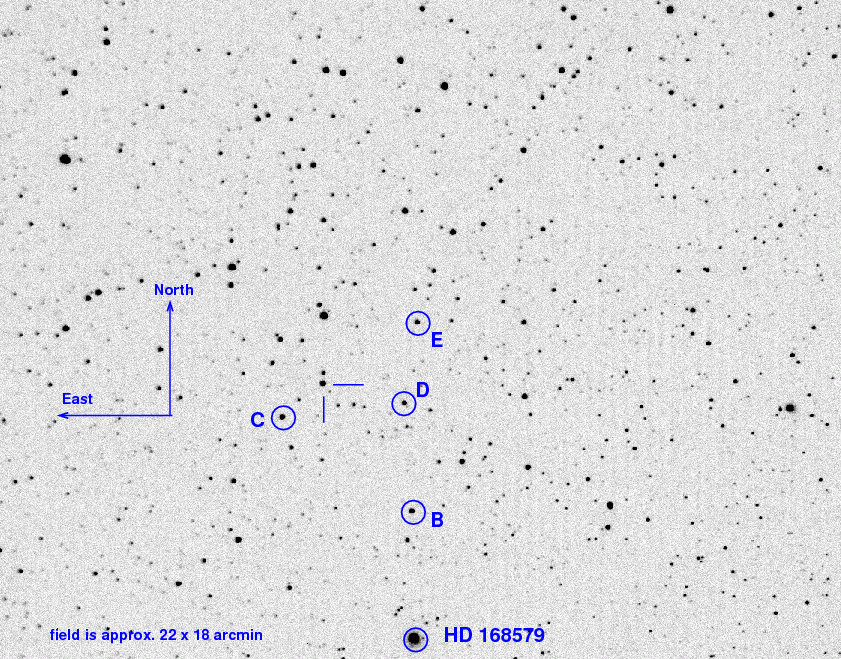
On the night of Aug 05/06 2018, from about 10:05 PM until 2:03 AM -- when the target reached high airmass -- through very hazy and occasionally cloudy skies, I acquired a set of observations of the likely black-hole system MAXIJ1820+070, (also known as ASASSN-18ey ).
On this night, I switched from no filter to using a V-band filter, in order to decrease the effects of extinction. The target now sinks low in the sky long before sunrise. This means longer exposure times, and more trouble guiding.
The main setup was:
Notes from the night:
This optical and X-ray and radio transient is likely a black hole accreting material at a higher-than-usual rate. It has been the subject of many observers over the past few months -- see the trail of telegrams that include
The object is located at
RA = 18:20:21.9 Dec = +07:11:07.3
A chart of the field is shown below. The size of the chart is about 22 by 18 arcminutes.
I've marked the location of several comparison stars, which also appear in light curves below. Stars C, D, and E are mentioned by the Tomoe Gozen team in ATel 11426, but all three are rather red, with (B-V) ranging from 1.14 to 1.37. Star B is one of the bluest nearby bright stars, with (B-V) = 0.52.
star UCAC4 B V ---------------------------------------------------- B 486-079513 12.975 12.454 C 486-079608 13.968 12.830 D 486-079523 14.637 13.272 E 487-077858 14.637 13.272 ----------------------------------------------------
I ran the camera at -12 C. Nothing out of the ordinary.

The sky value shows three brief periods of clouds. I stopped at airmass 1.90, due to very thick haze.

Here's a record of the telescope's drift. It is clear that the guider had trouble at times, and there was one period of thick cloud when it lost the guiderstar and moved in RA. A slow drift in Dec remains.
There's a steady drift in Dec, which probably means I need to adjust the altitude position a bit: try small motion CCW.
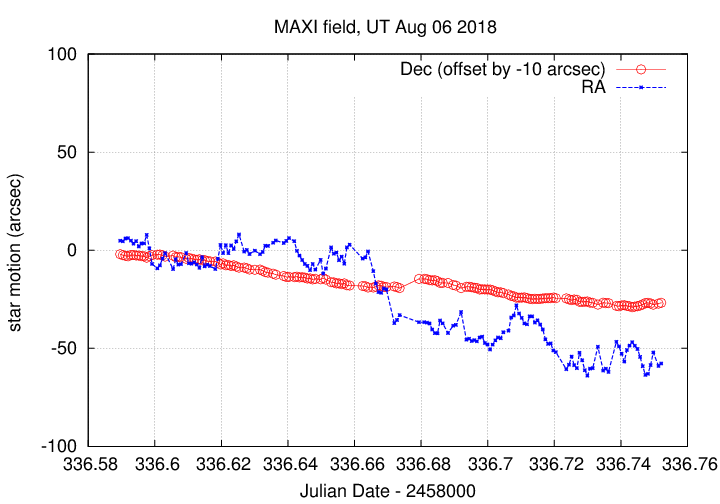
The number of objects detected -- I required 35 objects (not 50, as I changed from no filter to V) for an image to be included in the ensemble.
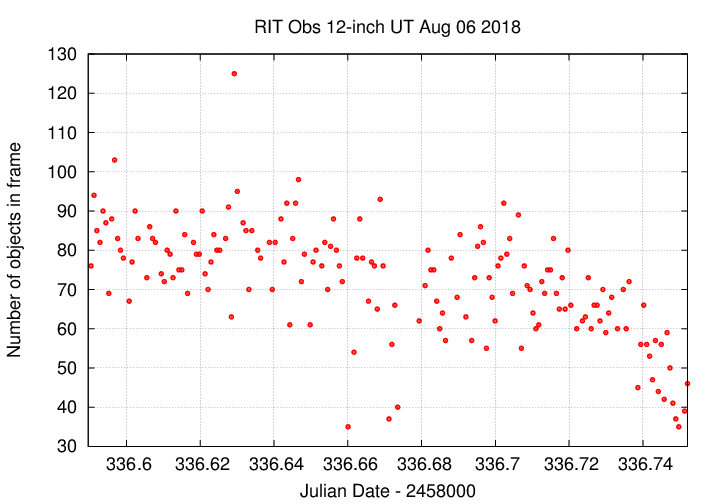
I used an aperture with radius 5.0 pixels.

I discarded images which had obvious trailed stellar images, using a threshold of "round > -0.60". (32 of the 202 raw images). I discarded 4 more images as well, due to large zero-point offsets.
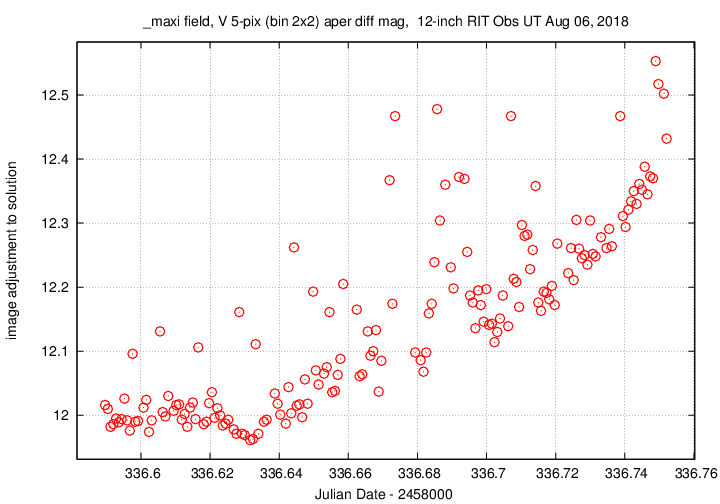
Using aperture photometry with a radius of 5 pixels (binned 2x2, each pixel is 1.34 arcsec, so a radius of 6.7 arcsec), I measured the instrumental magnitudes of a number of reference stars and the target. Following the procedures outlined by Kent Honeycutt's article on inhomogeneous ensemble photometry, I used all stars available in each image to define a reference frame, and measured each star against this frame.
Sigma-vs-mag plots show that the floor was about 0.005 mag overall, which is not bad. Star "A" was not saturated, due to the V-band filter cutting its light. Note that MAXI doesn't show as an outlier -- it didn't vary a lot.

Here are light curves of the variable and the field stars.
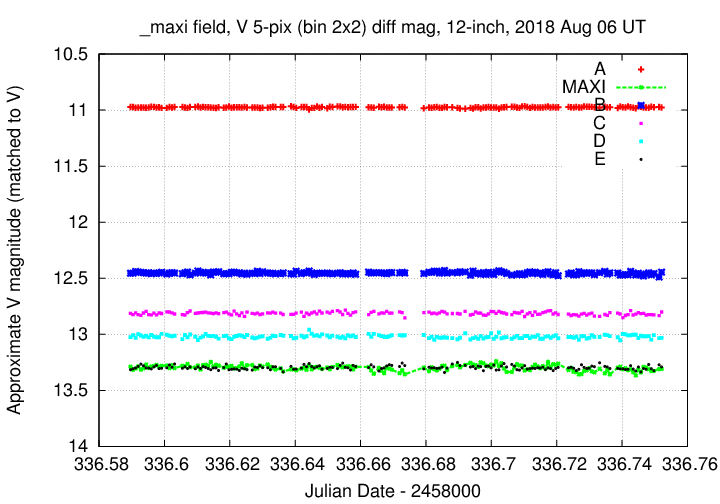
I used the UCAC value for the V-band magnitude of star "B" = UCAC4 486-079513 to shift the ensemble magnitudes to the standard V-band scale.
Here's a closeup on the variable. I'll connect the dots to make its behavior a bit easier to see.
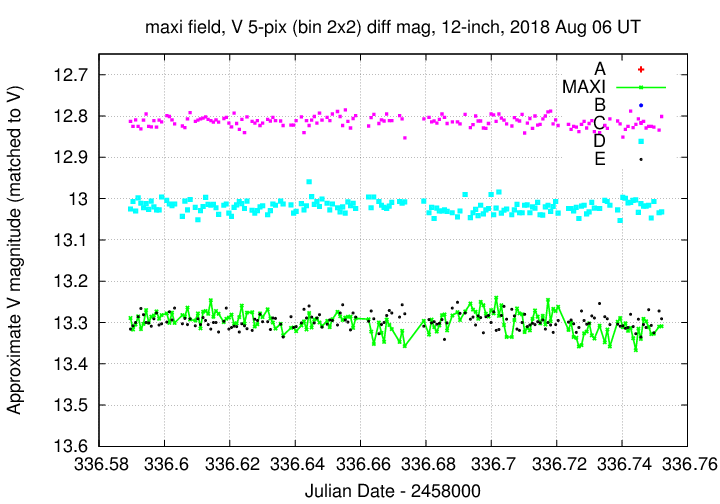
You can download my measurements below. A copy of the header of the file is shown to explain the format.
# Measurements of MAXIJ1820+070 made at RIT Obs, UT 2018 Aug 6, # in fair conditions, # by Michael Richmond, # using Meade 12-inch LX200 and ATIK 11000. # Exposures 60 seconds long, V filter. # Tabulated times are midexposure (FITS header time - half exposure length) # and accurate only to +/- 1 second (??). # 'mag' is a differential magnitude based on ensemble photometry # using a circular aperture of radius 5 pix = 6.6 arcseconds. # which has been shifted so UCAC4 486-079513 has mag=12.454 # which is its V-band magnitude according to UCAC4. # # UT_day JD HJD mag uncert Aug06.08962 2458336.58962 2458336.59362 13.289 0.018 Aug06.09041 2458336.59041 2458336.59441 13.317 0.020 Aug06.09119 2458336.59119 2458336.59519 13.305 0.019
Last modified 8/07/2018 by MWR.